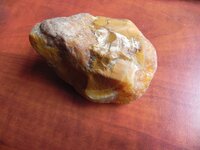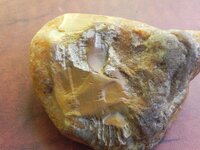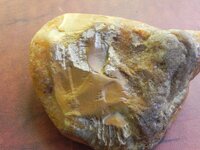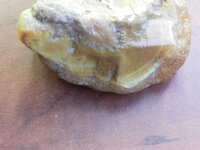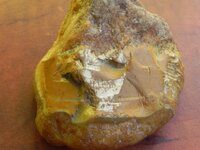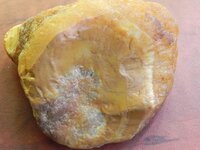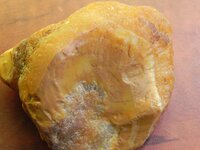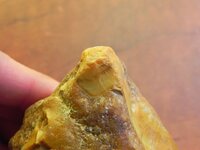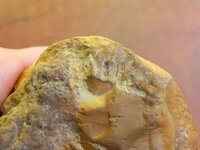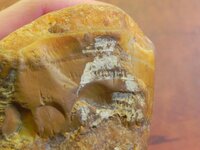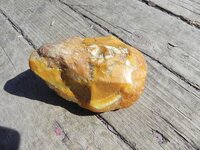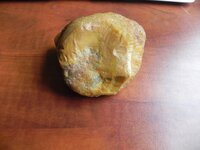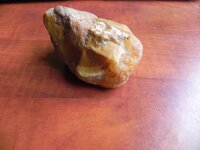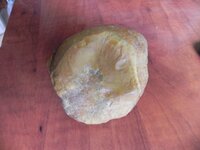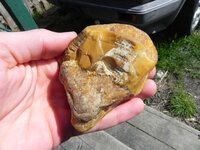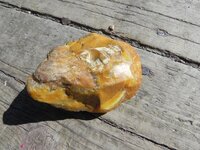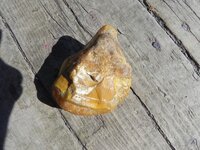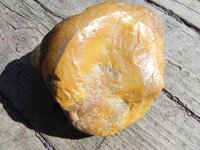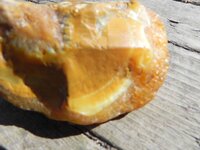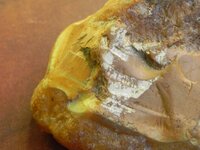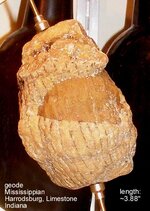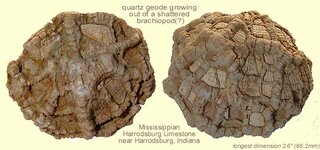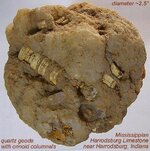You are using an out of date browser. It may not display this or other websites correctly.
You should upgrade or use an alternative browser.
You should upgrade or use an alternative browser.
Help identify this find, possibly petrified wood with crinoid imprint?
Tigger
Hero Member
I don't think it's pet wood, maybe coral?
Tigger
Hero Member
Try looking at it with a black light in a dark room, see if it fluoresces - some of the mineralization may be calcite?
Try looking at it with a black light in a dark room, see if it fluoresces - some of the mineralization may be calcite?
There is no crinoid in the mystery specimen, of course. Neither is it petrified wood, in my opinion--or coral, for that matter. Not biological, IMOPE (in my own personal estimation).
A better way to determine the possible presence of calcite is just use the scratch test. Lots of other stuff can flouresce (including such silicon dioxide minerals as agate). Take a knife and try to scratch if. If you can't scratch it, it's not calcite; no scratch equals a probable variety of silicon dioxide mineralization (AKA, silica). If you can scratch any part of it--then perhaps there's some calcite there.
Links to all of my paleontology-related pages available on the Net
Last edited:
Harry Pristis
Bronze Member
It's not uncommon to have traces of fossils in chert, flint, or jasper. As dense as these rocks are, they are sedimentary, so the SiO2 can incorporate a variety of organic remains. In some cases, the organic remains are the focus of the accumulation of silica in the sediment.
I see traces of something in your specimen that could be crinoid in origin. I doubt that you could get identification beyond that, if they are indeed crinoid traces.
Here are some examples of more-or-less identifiable fossils that served as foci for silica in the Harrodsburg Limestone (Mississippian):
I see traces of something in your specimen that could be crinoid in origin. I doubt that you could get identification beyond that, if they are indeed crinoid traces.
Here are some examples of more-or-less identifiable fossils that served as foci for silica in the Harrodsburg Limestone (Mississippian):
Whiplash00
Full Member
Horn coral?
Izual
Newbie
- Thread starter
- #9
this is from the surrounding creeks or shores of Lake Monroe, Indiana.
Thank you all very much for your input,
I believe the minerals surrounding the the specimen to be calcite, it can be chipped away.
though the glossy and smooth exposed sides of the specimen do not scratch with a knife.
Might it help in identifying the fossil type by chipping away the calcite or would that just be crazy?
Thanks again!!
Thank you all very much for your input,
I believe the minerals surrounding the the specimen to be calcite, it can be chipped away.
though the glossy and smooth exposed sides of the specimen do not scratch with a knife.
Might it help in identifying the fossil type by chipping away the calcite or would that just be crazy?
Thanks again!!
Harry Pristis
Bronze Member
Flint, calcite, and limestone are sedimentary in origin. They take many forms in nature. Flint and calcite commonly form in limestone from the dissolved tests of invertebrate fossils. You can distinguish between flint and calcite by using a drop of acid -- flint is inert, while calcite will fizz.
Top Member Reactions
-
 2408
2408 -
 1118
1118 -
 1117
1117 -
 905
905 -
 823
823 -
 807
807 -
 766
766 -
 733
733 -
 645
645 -
 518
518 -
 476
476 -
 468
468 -
 461
461 -
 429
429 -
 414
414 -
 408
408 -
O
369
-
 362
362 -
 353
353 -
 350
350
Users who are viewing this thread
Total: 2 (members: 0, guests: 2)
